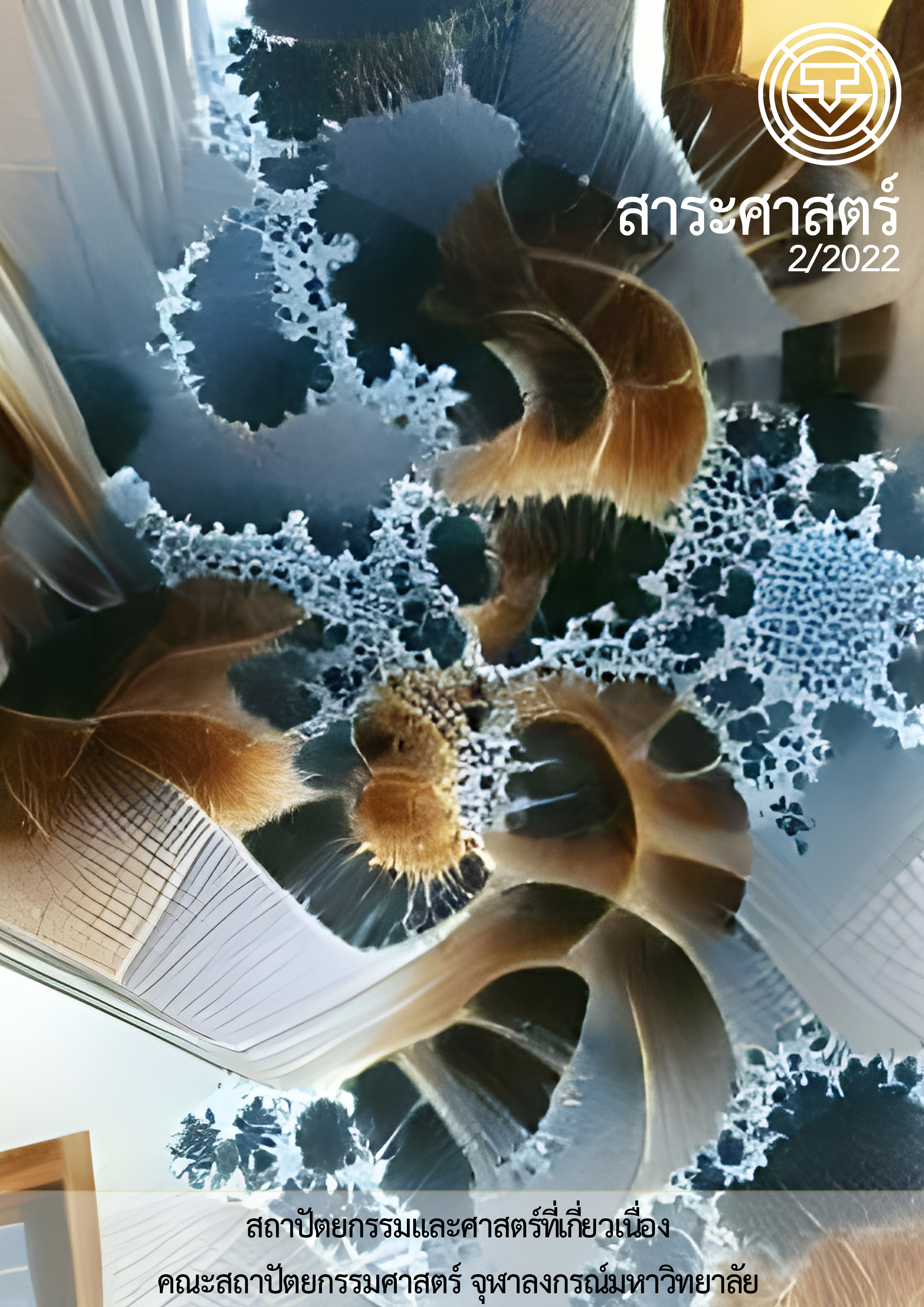แนวทางปรับปรุงพื้นที่ใช้งานส่วนให้บริการการแพทย์แผนไทย ภายใต้เแนวคิดการออกแบบเพื่อทุกคน กรณีศึกษา สถาบันการแพทย์แผนไทยอภัยภูเบศร โรงพยาบาลเจ้าพระยาอภัยภูเบศร
Main Article Content
บทคัดย่อ
บทความนี้ ได้ทำการศึกษาแนวทางปรับปรุงพื้นที่ใช้งานส่วนให้บริการการแพทย์แผนไทย ภายใต้เแนวคิดการออกแบบเพื่อทุกคน มีวัตถุประสงค์เพื่อศึกษาลักษณะพื้นที่ที่ส่งผลกระทบต่อการใช้งานภายใน สถาบันการแพทย์แผนไทยอภัยภูเบศร เพื่อเสนอแนะแนวทางในการปรับปรุงพื้นที่ใช้งานที่เหมาะสมกับพฤติกรรมของผู้ใช้งานพื้นที่ และสอดคล้องกับหลักการออกแบบเพื่อทุกคน
จากการศึกษาพบว่า พื้นที่ส่วนให้บริการแพทย์แผนไทยภายในสถาบันการแพทย์แผนไทย ประกอบด้วยลักษณะพื้นที่การใช้งาน 3 ส่วน คือ 1) ส่วนพื้นที่ต้อนรับ 2) ส่วนพื้นที่ตรวจรักษา และ 3) ส่วนพื้นที่สนับสนุน กิจกรรมส่วนใหญ่ภายในพื้นที่คือ การบำบัดและรักษา ด้วยศาสตร์การแพทย์แผนไทย การรักษาด้วยยาสมุนไพร รวมระยะเวลาในการเข้ารับการบำบัดและรักษาต่อ 1 ครั้ง เฉลี่ยเป็นเวลา 1 ชั่วโมง 30 นาที พื้นที่ฝังเข็มเป็นพื้นที่ที่มีความหนาแน่น และกระจุกตัวของผู้ใช้งานมากที่สุด แนวทางการปรับปรุงพื้นที่ใช้งานส่วนพื้นที่ต้อนรับ ควรมีป้ายที่ชัดเจนมองเห็นได้ง่าย มีพื้นที่สำหรับจอดรอวีลแชร์ เก้าอี้สำหรับพักคอย สามารถมองเห็นพื้นที่ให้บริการจุดถัดไปได้ง่าย เคาน์เตอร์สูงไม่เกิน 80 เซนติเมตร ลึกไม่น้อยกว่า 40 เซนติเมตร ส่วนพื้นที่ตรวจรักษา มีการกั้นห้องเพื่อความเป็นส่วนตัว ได้แก่ พื้นที่ห้องตรวจโรค พื้นที่อบสมุนไพร พื้นที่แช่สมุนไพร ประตูทางเข้ามีความกว้างอย่างน้อย 90 เซนติเมตร ภายในห้องมีการเว้นระยะห่างไม่น้อยกว่า 150 เซนติเมตร พื้นที่หัตถการแผนไทยสำหรับนวดและประคบ มีการแยกห้อง ชาย/หญิง ทั้งแบบห้องนวดเดี่ยว และห้องนวดรวม เตียงนวดมีระยะห่างระหว่างเตียงอย่างน้อย 90 เซนติเมตร ข้างเตียงมีตู้เตี้ยสำหรับวางของ ส่วนพื้นที่สนับสนุน มีห้องน้ำสำหรับผู้พิการ มีการแยกห้องน้ำ ห้องเปลี่ยนเสื้อผ้า และห้องอาบน้ำ เพื่อลดการเกิดอุบัติเหตุจากพื้นที่ลื่นและเปียกน้ำ
Article Details
เอกสารอ้างอิง
กรมการแพทย์แผนไทยและการแพทย์ทางเลือก. (2560). คู่มือสาหรับผู้บริหารงานด้านการแพทย์แผนไทยและการแพทย์ผสมผสาน. ปทุมธานี: มหาวิทยาลัยธรรมศาสตร์.
กรมการแพทย์แผนไทยและการแพทย์ทางเลือก. (2560). ประกาศผลการประกวดพื้นที่ต้นแบบดีเด่นแห่งชาติด้านการแพทย์แผนไทย การแพทย์พื้นบ้านและการแพทย์ทางเลือก ประจำปี 2560. สืบค้นเมื่อ 20 สิงหาคม 2563, จากhttps://www.dtam.moph.go.th/images/PR/pr0760-22082560.pdf
กรมพัฒนาการแพทย์แผนไทยและการแพทย์ทางเลือก สถาบันการแพทย์แผนไทย กลุ่มงานส่งเสริมภูมิปัญญาการแพทย์แผนไทยและสมุนไพร. (2556).มาตรฐานโรงพยาบาลส่งเสริมและสนับสนุนการแพทย์แผนไทยและการแพทย์ผสมผสาน (รพ.สส.พท.). กรุงเทพฯ: องค์การสงเคราะห์ทหารผ่านศึก.
กระทรวงสาธารณสุข กรมการแพทย์แผนไทยและการแพทย์ทางเลือก สำนักงานข้อมูลและคลังความรู้. (2559). รายงานการสาธารณสุขไทย ด้านการแพทย์แผนไทยการแพทย์พื้นบ้านและการแพทย์ทางเลือก 2557 – 2559. กรุงเทพฯ: ชุมนุมสหกรณ์การเกษตรแห่งประเทศไทย.
จรัญญา พหลเทพ. (2561). การตรวจสอบประสิทธิภาพการเข้าถึงพื้นที่ให้บริการด้วยกระบวนการประเมินภายหลังการเข้าใช้พื้นที่อย่างครอบคลุมภายใต้แนวคิดการออกแบบเพื่อทุกคน กรณีศึกษา พื้นที่ให้บริการส่วนกลางภายในโรงพยาบาลมหาวิทยาลัยนเรศวร. วารสารวิชาการคณะสถาปัตยกรรมศาสตร์ สจล., 26(1), 160-172.
ไตรรัตน์ จารุทัศน์. (2558). คู่มือการออกแบบเพื่อทุกคน (พิมพ์ครั้งที่ 2). กรุงเทพฯ: โรงพิมพ์เทพเพ็ญวานิสย์.
วัลลภา คงฉันท์มิตรกุล และ คานาง กาสนิท. (2562). สถานการณ์การให้บริการการแพทย์แผนไทยในจังหวัดนครราชสีมา.วารสารวิจัยและพัฒนาด้านสุขภาพ, 5(2), 53-66.
ศักดา สถิรเรืองชัย. (2556). การรักษาความลับของผู้ป่วย. วารสารเวชบันทึกศิริราช, 6(2), 78-83.
ศูนย์การแพทย์ทางเลือก. (2564). รายงานข้อมูลสถิติการให้บริการผู้ป่วยนอกปีงบประมาณ 2564. สืบค้นเมื่อ 27 ธันวาคม 2564, จาก https://thaicam.go.th/ข้อมูลสถิติการให้บริการ/
สมาคมสถาปนิกสยาม ในพระบรมราชูปถัมภ์. (2557). ข้อแนะนำการออกแบบสิ่งอำนวยความสะดวกสำหรับทุกคน. กรุงเทพฯ: บริษัท พลัสเพรส จำกัด.
Larysa, B., & Olena, I. (2019). Universal design in healthcare. [n.p.].: UNDP.
Kompany, S., & Briand, D. (2011). Hospital: Universal design and accessibility for all (pp.103-105).4 th ECHE - 51 st IHF Conference. [n.p.].


